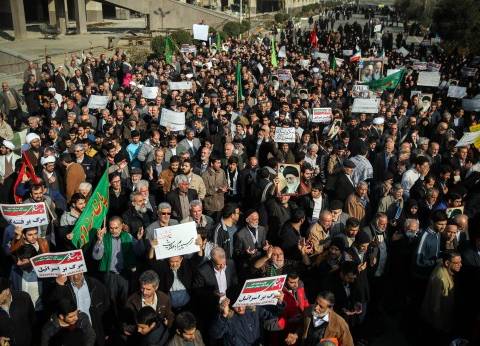|
Iran is experiencing a political earthquake. The fault lines are clear: On the one side, the theocratic regime and its suppressive forces; on the other, the Iranian people. At least two dozen cities across the country witnessed large-scale demonstrations on Friday and Saturday against a regime that has been sorely incapable of addressing the country’s economic and political demands. The protests have now grown over 50 cities and several protesters have been shot dead as security forces opened fire..
“Death to the dictator” is once again echoing among Iran’s struggling population, mainly youths and women. For months, thousands of people have been protesting in various quarters, demanding justice for the plundering of their wealth by institutions tied to the “supreme leader” and the Islamic Revolutionary Guard Corps. However, the scale and political orientation of the Dec. 29 and 30 protests were striking and remarkable.
.
“The people live like beggars/(Khamenei) lives like a God,” thousands of demonstrators chanted in several towns on Dec. 30.
.
One of the most interesting chants in Tehran’s protests Sunday was “Reformists, hard-liner, game is over now,” reflecting the desire by Iranians for regime change.
.
On Thursday, Iran’s second-largest city, Mashhad, saw the spark of the protests. Several thousand people began their demonstrations by complaining about rising commodity prices (in some cases, food prices have seen a 20-30 percent hike in the last week alone).
.
Quickly, however, the protests were reoriented toward the regime’s senior officials, including President Hassan Rouhani and supreme leader Ali Khamenei: “Death to Rouhani,” “Death to Khamenei,” and “Death to the dictator,” the protesters chanted.
.
Then on Friday, the cities of Kermanshah, Shiraz, Rasht, Qom, Hamedan, Ahvaz, Isfahan, Zahedan, Qazvin, and Sari rose up, joined by a large number of smaller towns. There are several noteworthy characteristics about what has been reported thus far.
.
First, the political nature of the protests has been made clear from the start, although the underlying impetus was the economic situation and particularly the vast financial corruption permeating the regime.
Khamenei, as the main figure of the theocracy, has been a permanent fixture in the protesters’ slogans. And protesters continue to call on the regime to “Free all political prisoners.”
.
Second, the regime’s main players were quick to point out that there is a leading opposition movement that can lead the protests toward their final destination: the regime’s downfall.
.
During at least seven Friday prayer sessions across Iran, senior mullahs pointed the finger at the opposition and other foreign governments.
.
The state security and anti-riot forces were out in full force, using water cannons to disperse crowds and drawing chants of “Shame on you” from crowds who refused to give up any ground.
The fearlessness, courage and leading role of women has been exceptional. Dozens of video clips circulating on social media attest to this. In one case, a woman stands in front of security forces and shouts “Death to Khamenei,” an offense that could carry the death penalty.
.
Trump must reach out to the Iranians paying the ultimate price to bring down a common enemy.The third prominent characteristic of the recent rallies is that the protesters are clearly drawing a line between the Iranian people’s desired policies and those actually carried out by Tehran. These include the regime’s disastrous regional policies, including its wars in Syria, Yemen and Iraq.
Dr. Majid Rafizadeh
.
In many cities, including Zahedan, young demonstrators, in a country where unemployment is running rampant, chanted: “Leave Syria alone, think about us instead.”
.
Protesters in the city of Qom, the home of the main religious seminary, chanted “Death to Hezbollah.” Others chanted “Forget Gaza, forget Lebanon; I’d give my life for Iran.”
All political and economic indications are that protests in Iran will continue to grow.
.
Just eight years earlier, the people of Iran rose up in their millions against the dictatorship. The US administration at the time stayed abhorrently silent, provoking people on the streets to chant, “Obama, Obama, are you with them [mullahs] or with us?”
.
Washington did not offer support, enabling the mullahs to brutally crushed the demonstrations with impunity. The mullahs were even rewarded with a flawed nuclear deal and billions of dollars.
.
In a statement after the recent demonstrations, the US State Department said: “On June 14, 2017, Secretary Tillerson testified to Congress that he supports ‘those elements inside of Iran that would lead to a peaceful transition of government. Those elements are there, certainly as we know.’ The secretary today repeats his deep support for the Iranian people.”
.
It is time for the administration of US President Donald Trump to go beyond words, however, and to actively reach out.
.
President Trump should lend moral support to millions of Iranians who are paying the ultimate price to bring down a common enemy: The evil dictatorship in Iran that is bent on nuclear weapons and regional domination. They need us just as much as we need them.
.
• Dr. Majid Rafizadeh is a Harvard-educated Iranian-American political scientist. He is a leading expert on Iran and US foreign policy, a businessman and president of the International American Council. He serves on the boards of the Harvard International Review, the Harvard International Relations Council and the US-Middle East Chamber for Commerce and Business. Twitter: @Dr_Rafizadeh
http://www.arabnews.com/node/1217251

Comments
Post a Comment